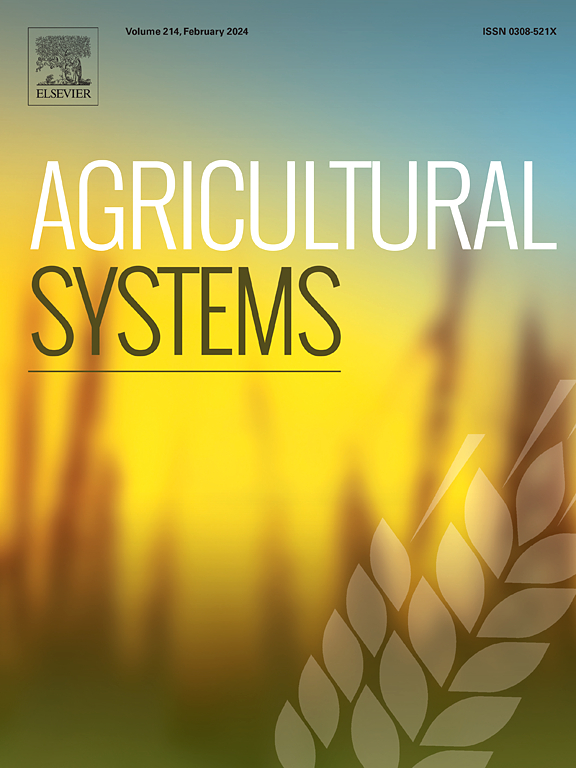Carbon neutrality and beef production in the marginal areas: A case study of Podolian cattle system
IF 6.1
1区 农林科学
Q1 AGRICULTURE, MULTIDISCIPLINARY
引用次数: 0
Abstract
CONTEXT
The Sixth Assessment Report of the Intergovernmental Panel on Climate Change stated that human activities caused global warming, mainly through emissions of greenhouse gases (GHGs); livestock supply chains contribute 14.5 % of global anthropogenic GHG emissions, with cattle (beef, milk) accounting for about two-thirds of that total, mainly due to methane emissions resulting from enteric fermentation.
OBJECTIVE
This study aimed to assess the environmental sustainability of the Podolian beef production system in marginal areas of Southern Italy (specifically the Basilicata region) through the Life Cycle Assessment (LCA) approach and identify suitable mitigation strategies.
METHODS
The environmental impact of Podolian beef production was assessed using the following indicators: Global warming potential (GWP100, kg CO2 eq), Freshwater eutrophication (FEP, g P eq), Terrestrial acidification (TAP, g SO2 eq), Marine eutrophication (MEP, g N eq), Land use (LOP, m2 year crop eq), Fossil resource scarcity (FFP, g oil eq), Mineral resource scarcity (SOP, g Cu eq), and Fine particulate matter formation (PMFP, g PM 2.5 eq). The boundaries of the beef production systems encompassed a cradle-to-farm gate analysis. Three functional units (FU) were used: kg of live weight (LW) at slaughter, kg of carcass weight (CW) and hectare of land. Additionally, carbon sequestration from permanent pasture and woodland was calculated.
RESULTS AND CONCLUSIONS
Our case study evaluated the main impact categories of livestock farming for beef production. The results of GWP100 were higher than the European average for the three functional units considered. As the overall outcome is the total deducted the 39 % due to grassland management. Achieving carbon neutrality would require 16.7 ± 4.9 m2 of woodland per kg of LW or 30.8 ± 9.0 m2 of woodland per kg of CW.
SIGNIFICANCE
Our study indicates that the environmental impact per kilogram of beef produced in marginal contexts is generally higher than in intensive livestock farming systems. However, delving deeper into the specific context and accounting for carbon sequestration from pastures used in this cattle farming allows to achieve environmental performance comparable to the most efficient intensive systems. Specifically, we identified the wooded area resource within the Podolian cattle farming system as an existing mitigation strategy which requires effective management and preservation. This study provides more explicit guidance to policymakers and consumers on the environmental implications of different meat production practices, supporting more informed planning of regional, national, and European resources.

边缘地区的碳中和与牛肉生产:以波多利安牛系统为例
政府间气候变化专门委员会第六次评估报告指出,人类活动导致全球变暖,主要是通过排放温室气体(GHGs);畜牧业供应链贡献了全球人为温室气体排放的14.5%,其中牛(牛肉、牛奶)约占总量的三分之二,主要是由于肠道发酵产生的甲烷排放。本研究旨在通过生命周期评估(LCA)方法评估意大利南部边缘地区(特别是巴西利卡塔地区)波多利安牛肉生产系统的环境可持续性,并确定合适的缓解策略。方法采用全球变暖潜势(GWP100, kg CO2 eq)、淡水富营养化(FEP, g P eq)、陆地酸化(TAP, g SO2 eq)、海洋富营养化(MEP, g N eq)、土地利用(LOP, m2年作物eq)、化石资源稀缺(FFP, g oil eq)、矿产资源稀缺(SOP, g Cu eq)、细颗粒物形成(PMFP, g PM 2.5 eq)等指标,对波多里安牛肉生产的环境影响进行评价。牛肉生产系统的边界包括从摇篮到农场的大门分析。采用3个功能单位(FU):活重kg (LW)、胴体重kg (CW)和公顷土地。此外,还计算了永久牧场和林地的固碳量。结果与结论本案例评估了畜牧业对牛肉生产的主要影响类别。GWP100的结果高于欧洲三个功能单元的平均水平。由于总体结果是减去39%由于草原管理的结果。要实现碳中和,每千克低碳水化合物需要16.7±4.9 m2的林地,每千克碳水化合物需要30.8±9.0 m2的林地。意义我们的研究表明,在边缘地区生产的每公斤牛肉对环境的影响通常高于集约化畜牧业系统。然而,深入研究具体情况并考虑这种养牛场所使用的牧场的碳固存,可以实现与最有效的集约化系统相当的环境绩效。具体来说,我们确定了Podolian牛养殖系统内的林地资源是一种现有的缓解策略,需要有效的管理和保护。这项研究为决策者和消费者就不同肉类生产方式的环境影响提供了更明确的指导,支持对区域、国家和欧洲资源进行更明智的规划。
本文章由计算机程序翻译,如有差异,请以英文原文为准。
求助全文
约1分钟内获得全文
求助全文
来源期刊

Agricultural Systems
农林科学-农业综合
CiteScore
13.30
自引率
7.60%
发文量
174
审稿时长
30 days
期刊介绍:
Agricultural Systems is an international journal that deals with interactions - among the components of agricultural systems, among hierarchical levels of agricultural systems, between agricultural and other land use systems, and between agricultural systems and their natural, social and economic environments.
The scope includes the development and application of systems analysis methodologies in the following areas:
Systems approaches in the sustainable intensification of agriculture; pathways for sustainable intensification; crop-livestock integration; farm-level resource allocation; quantification of benefits and trade-offs at farm to landscape levels; integrative, participatory and dynamic modelling approaches for qualitative and quantitative assessments of agricultural systems and decision making;
The interactions between agricultural and non-agricultural landscapes; the multiple services of agricultural systems; food security and the environment;
Global change and adaptation science; transformational adaptations as driven by changes in climate, policy, values and attitudes influencing the design of farming systems;
Development and application of farming systems design tools and methods for impact, scenario and case study analysis; managing the complexities of dynamic agricultural systems; innovation systems and multi stakeholder arrangements that support or promote change and (or) inform policy decisions.
 求助内容:
求助内容: 应助结果提醒方式:
应助结果提醒方式:


